drought
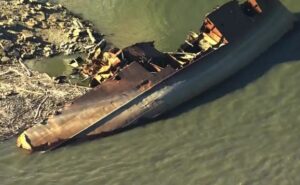
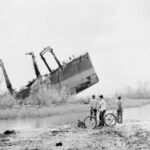 Some years are filled with rainy and snowy days, while others are drought filled, like this one. Each can have their consequences, if things go too far. As drought in the United States has progressed this past year, lakes and rivers have dried up, including the widest river…the great Mississippi River, which is not nearly as wide or as deep as it used to be. The reality is that suddenly, the Mississippi is bone-dry in some places. The average depth of the Mississippi River is normally 9 to 12 feet, with the deepest point being 200 feet. As with any river that is deep enough to run big boats or even little ones, invariably, there comes a sinking or two.
Some years are filled with rainy and snowy days, while others are drought filled, like this one. Each can have their consequences, if things go too far. As drought in the United States has progressed this past year, lakes and rivers have dried up, including the widest river…the great Mississippi River, which is not nearly as wide or as deep as it used to be. The reality is that suddenly, the Mississippi is bone-dry in some places. The average depth of the Mississippi River is normally 9 to 12 feet, with the deepest point being 200 feet. As with any river that is deep enough to run big boats or even little ones, invariably, there comes a sinking or two.
Sometimes, boats that sink can be recovered, and sometimes they can’t. The ship might be at a depth that makes it impossible, or the right equipment might not be available. Whatever the reason, in just about any body of water, there are bound to be a few mysterious finds hiding beneath the surface. As the Mississippi River has gone through the drought this year, there are the expected myriad of boats that are now stranded and languishing on dry land, but there are also a few surprises that are starting to appear. Some of the ships are old, but some are not as old, like the Diamond Lady, a casino boat that used to grace the mighty river. The Diamond Lady was christened in 1991, and was used in Iowa for a time, but in 2019, as things in Iowa got tough, the beautiful casino boat sailed south to an unknown fate in the mighty Mississippi River. The boat had been stored in Lake McKellar, but sank in 2021 during a freeze. Now it has resurfaced again. It’s not the oldest relic in the Mississippi River and the surrounding waterways, but it might have been the most majestic.
Unfortunately, there are sad finds in the river too. The drought has unearthed a sunken 19th-century shipwreck and human remains in the Mississippi River. I’m sure these won’t be the only human remains that suddenly surface, because while drowning victims are often found, there comes with a gambling a certain element that 
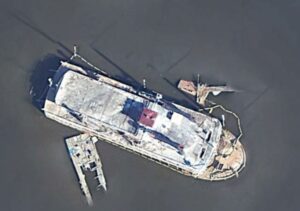 often brings the mysterious deaths, whether they are murders or just mysterious deaths whose cause cannot be determined. I’m sure there will be more ship, and possibly more bodies that turn up too. Then, before too long, the waters will return, and the mysteries will once again be hidden beneath the surface of the rivers and lakes.
often brings the mysterious deaths, whether they are murders or just mysterious deaths whose cause cannot be determined. I’m sure there will be more ship, and possibly more bodies that turn up too. Then, before too long, the waters will return, and the mysteries will once again be hidden beneath the surface of the rivers and lakes.
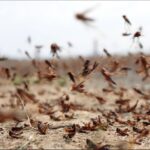
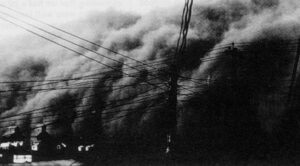 No matter where you live, I’m sure you have had encounters with grasshoppers. They are an unfortunate fact of life in this world. Some years are worse than others, and some areas are worse than others too. There are a few facts about grasshoppers that I didn’t know about, and some I did. Unfortunately, there are no chemical pesticides to control grasshoppers, but since cool, moist conditions slow them down and encourage the growth of fungi (which cause disease in grasshoppers), keeping plant beds moist and well irrigated may help ward them off. To protect small areas, try using a sticky paper or screening. Most of us find that in dry hot years, the grasshoppers make us as miserable as the heat. Never was that more evident than on July 26, 1931, when a swarm of grasshoppers descended on crops throughout America’s heartland, devastating millions of acres. Iowa, Nebraska, and South Dakota were already suffering from a bad drought that brought severe damage to the crops in the region. The grasshoppers really just finished them off.
No matter where you live, I’m sure you have had encounters with grasshoppers. They are an unfortunate fact of life in this world. Some years are worse than others, and some areas are worse than others too. There are a few facts about grasshoppers that I didn’t know about, and some I did. Unfortunately, there are no chemical pesticides to control grasshoppers, but since cool, moist conditions slow them down and encourage the growth of fungi (which cause disease in grasshoppers), keeping plant beds moist and well irrigated may help ward them off. To protect small areas, try using a sticky paper or screening. Most of us find that in dry hot years, the grasshoppers make us as miserable as the heat. Never was that more evident than on July 26, 1931, when a swarm of grasshoppers descended on crops throughout America’s heartland, devastating millions of acres. Iowa, Nebraska, and South Dakota were already suffering from a bad drought that brought severe damage to the crops in the region. The grasshoppers really just finished them off.
Anyone who has grown a garden, crops, trees, and even grass, have struggled to prevent insects from eating their crops or plants. Locusts and grasshoppers, which are insect cousins, are among the most feared pests. If the conditions are right, their populations can suddenly explode, and while just their presence is enough to make most people’s skin crawl, the speed with which they are able to eat through a field of crops is impossible to comprehend, unless they have witnessed it for themselves. A plague of these insects occurs when drought conditions cause their populations to suddenly explode. The egg pods don’t do well in wet conditions, so when the soil is very dry, swarms can develop. “They explode from beneath your feet. There’s sort of a rolling wave that forms out in front of you. They hit up against your body and cling against your clothes. It’s almost like being immersed in a gigantic living being,” says Professor Jeff Lockwood of Wyoming.
The swarm in July of 1931 was so thick that it actually blocked out the sun. The grasshoppers had to be scooped up with a shovel. They ate the cornstalks down to the ground, leaving just stubs, and they ate 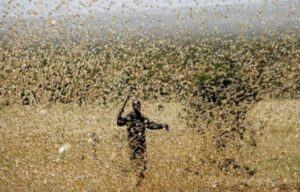
 everything in the fields, down to the bare ground. Thankfully, the United States hasn’t seen swarms since the early 1930s. Many other areas of the world are not so fortunate. North Africa and parts of the Middle East continue to experience problems with insect swarms. In fact, the swarms in some of those areas have involved as many as a billion bugs. I don’t know about you, but now my skin is really crawling. Eeeeeeewwwwwwww!!
everything in the fields, down to the bare ground. Thankfully, the United States hasn’t seen swarms since the early 1930s. Many other areas of the world are not so fortunate. North Africa and parts of the Middle East continue to experience problems with insect swarms. In fact, the swarms in some of those areas have involved as many as a billion bugs. I don’t know about you, but now my skin is really crawling. Eeeeeeewwwwwwww!!
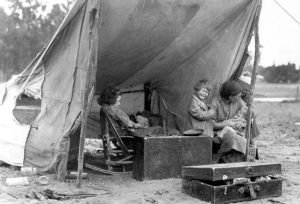
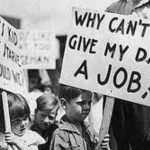 Following the Crash of 1929, which occurred on October 29, 1929, people quickly found that the jobs they thought were secure, were not only not secure, they were gone. That day became known as Black Tuesday. It was the day the stock market took a huge hit, as investors traded some 16 million shares on the New York Stock Exchange in a single day. Billions of dollars were lost, wiping out thousands of investors. The Great Depression followed the crash of 1929…banks failed, businesses closed, city streets were desolate, families lost their homes, and unemployment in rose to nearly 25%. The crash was the culmination of many years of economic instability. In the middle part of the United States, the depression occurred during the drought season. The farmers quickly lost their lands, because their crops died out, and many became migrant workers. They traveled around the country, hoping to find work for all members of the family in exchange for a meal or a place to sleep. Husbands and fathers traveled great distances from their homes in search of any work that they could find. There was no work…anywhere. Times were just about the worst they could possibly be.
Following the Crash of 1929, which occurred on October 29, 1929, people quickly found that the jobs they thought were secure, were not only not secure, they were gone. That day became known as Black Tuesday. It was the day the stock market took a huge hit, as investors traded some 16 million shares on the New York Stock Exchange in a single day. Billions of dollars were lost, wiping out thousands of investors. The Great Depression followed the crash of 1929…banks failed, businesses closed, city streets were desolate, families lost their homes, and unemployment in rose to nearly 25%. The crash was the culmination of many years of economic instability. In the middle part of the United States, the depression occurred during the drought season. The farmers quickly lost their lands, because their crops died out, and many became migrant workers. They traveled around the country, hoping to find work for all members of the family in exchange for a meal or a place to sleep. Husbands and fathers traveled great distances from their homes in search of any work that they could find. There was no work…anywhere. Times were just about the worst they could possibly be.
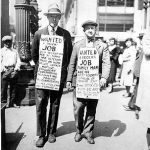
Architects, bankers, engineers and educators suddenly found themselves standing in long unemployment lines, competing for menial, basic jobs with pay that was barely enough to put food on their tables. Men who had defined themselves by taking care of their families, being the breadwinner, struggled with the emotional depression that came with the economic depression. As men traveled farther and farther away from home looking for jobs, they are forced to find lodging in public housing or shelters, waking up to begin job hunting again the next morning. Husbands and fathers who had previously earned enough money to feed and clothe their families were forced to stand in bread lines to receive free food so their families would not starve.
People became so desperate for work. As men went from town to town, they were met with billboard signs telling them to keep going, because there was no work in the town. Men with families even got their children involved, carrying signs asking why no one would hire their dad. Then men started wearing their resume on cardboard placards that they wore as they walked along. It seemed incredulous to the men who had been in higher paid jobs, that they could no longer find work…even with their qualifications. Signs like one saying, “I know 3 trades, I speak 3 languages, fought for 3 years, have 3 children and no work for 3 months. But I only 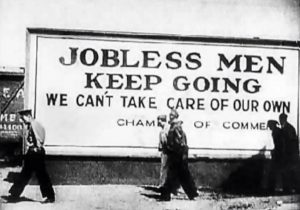
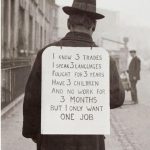 want one job,” appeared everywhere. Times couldn’t possibly get worse. While there’s no consensus about the exact end of the Great Depression among economic historians, the unemployment rate remained high for the rest of the 1930s, even as the banking crisis eased up. One major event, however, shifted the focus of the country away from the Great Depression. After the Japanese attack on Pearl Harbor on December 7, 1941, millions of men and women would join the work force as the US entered World War II.
want one job,” appeared everywhere. Times couldn’t possibly get worse. While there’s no consensus about the exact end of the Great Depression among economic historians, the unemployment rate remained high for the rest of the 1930s, even as the banking crisis eased up. One major event, however, shifted the focus of the country away from the Great Depression. After the Japanese attack on Pearl Harbor on December 7, 1941, millions of men and women would join the work force as the US entered World War II.
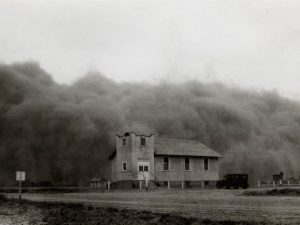
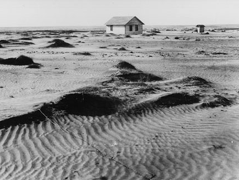 Drought…anywhere and at any time, is a perilous situation. Crops can’t grow, and food prices go up. But when a drought happens in the middle of an economic depression, it is catastrophic. The Dust Bowl, which was also known as the Dirty Thirties, was a period of severe dust storms during the 1930s. Mistakes were made during this drought…mistakes like a failure to implement dryland farming methods to prevent wind erosion caused the Dust Bowl. The drought came in three waves…1934, 1936, and 1939–40, but some regions of the high plains experienced drought conditions for as many as eight years. The people had no real understanding of the ecology of the plains. The farmers had plowed deep into the virgin topsoil of the Great Plains during the previous decade. This displacement of the native, deep-rooted grasses that normally trapped soil and moisture even during periods of drought and high winds were gone. During the drought of the 1930s, the unanchored soil turned to dust, which the prevailing winds blew away in huge clouds that sometimes blackened the sky. These choking clouds of dust…named “black blizzards” or “black rollers” traveled cross country. The Dust Bowl forced tens of thousands of families to abandon their farms.
Drought…anywhere and at any time, is a perilous situation. Crops can’t grow, and food prices go up. But when a drought happens in the middle of an economic depression, it is catastrophic. The Dust Bowl, which was also known as the Dirty Thirties, was a period of severe dust storms during the 1930s. Mistakes were made during this drought…mistakes like a failure to implement dryland farming methods to prevent wind erosion caused the Dust Bowl. The drought came in three waves…1934, 1936, and 1939–40, but some regions of the high plains experienced drought conditions for as many as eight years. The people had no real understanding of the ecology of the plains. The farmers had plowed deep into the virgin topsoil of the Great Plains during the previous decade. This displacement of the native, deep-rooted grasses that normally trapped soil and moisture even during periods of drought and high winds were gone. During the drought of the 1930s, the unanchored soil turned to dust, which the prevailing winds blew away in huge clouds that sometimes blackened the sky. These choking clouds of dust…named “black blizzards” or “black rollers” traveled cross country. The Dust Bowl forced tens of thousands of families to abandon their farms.
The drought, along with the already depressed economy, caused many people to have very little money. It was during this time that people had to get creative to meet their needs. Enter the flour sack…say what!! Yes, the flour sack. When the people didn’t have money for fabric to make clothing, they began to use the cloth flour sacks as material for clothing. Then, some industrious flour distributor somewhere decided to assist the people. The flour sacks began to have pretty designs on them. Just because the people were going to use the sacks for clothing, didn’t mean that they had to look like they were wearing a flour sack. It didn’t matter that everyone knew it was a flour sack either. It looked pretty, and that really helped with morale. In reality, cloth is cloth, but I suppose the flour sacks were not of the normal dress quality. Still, when that was all you had, you did what you had to do. When you are given lemons, make lemonade, and all…right.
As the flour sacks began to be prettier, the dresses became quite fashionable, and looking back on some of the dresses that were made, I doubt that most people would know the difference between a flour sack dress and any other dress…had they not been told. The people of those times really got quite creative in meeting the 
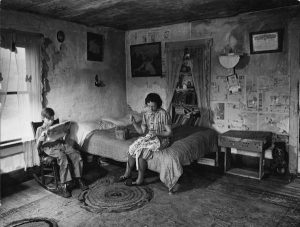 needs of the family…clothing, furniture, or even their houses…people persevered. Of course, food was a little bit more difficult in those days, because if the crops wouldn’t grow, you simply had to find something else to eat. I’m sure there were a lot of people who were pretty skinny in those days…as well as pretty hungry. Nevertheless, with the help of creative mothers, and industrious flour distributors, the girls looked very nice, and quite fashionable.
needs of the family…clothing, furniture, or even their houses…people persevered. Of course, food was a little bit more difficult in those days, because if the crops wouldn’t grow, you simply had to find something else to eat. I’m sure there were a lot of people who were pretty skinny in those days…as well as pretty hungry. Nevertheless, with the help of creative mothers, and industrious flour distributors, the girls looked very nice, and quite fashionable.
 I think most people have heard of the Great Chicago Fire of 1871, but few have heard of the Great Peshtigo Fire of 1871, that started the same day, October 8, 1871. I’m sure that Chicago, being a much bigger city, made it a fire that stuck in the minds of the people, but in reality, the Great Peshtigo Fire was far more deadly. The Chicago fire burned an area about four miles long and almost a mile wide through the Windy City, including its business district. The fire destroyed thousands of buildings, killed an estimated 300 people and caused an estimated $200 million in damages. That is a horrible fire, and a horrible loss of life and property, but it truly pales in comparison to the Great Peshtigo Fire. The Great Peshtigo Fire took place in the area around Peshtigo, Wisconsin and the death toll was estimated at around 1,500 people, and possibly as many as 2,500. I suppose that it seems odd for the estimate to be a difference of as many as a thousand people, but when the fire was finally out, twelve communities were destroyed. An accurate death toll has never been determined because local records were destroyed in the fire. Between 1,500 and 2,500 people are thought to have lost their lives. The 1873 Report to the Wisconsin Legislature listed 1,182 names of deceased or missing residents. In 1870, the Town of Peshtigo had 1,749 residents. More than 350 bodies were buried in a mass grave, primarily because so many had died that no one remained alive who could identify many of them. In the end, over, 1,875 square miles, or 1.2 million acres of forest had been consumed, an area approximately twice the size of Rhode Island. Some sources list 1.5 million acres burned.
I think most people have heard of the Great Chicago Fire of 1871, but few have heard of the Great Peshtigo Fire of 1871, that started the same day, October 8, 1871. I’m sure that Chicago, being a much bigger city, made it a fire that stuck in the minds of the people, but in reality, the Great Peshtigo Fire was far more deadly. The Chicago fire burned an area about four miles long and almost a mile wide through the Windy City, including its business district. The fire destroyed thousands of buildings, killed an estimated 300 people and caused an estimated $200 million in damages. That is a horrible fire, and a horrible loss of life and property, but it truly pales in comparison to the Great Peshtigo Fire. The Great Peshtigo Fire took place in the area around Peshtigo, Wisconsin and the death toll was estimated at around 1,500 people, and possibly as many as 2,500. I suppose that it seems odd for the estimate to be a difference of as many as a thousand people, but when the fire was finally out, twelve communities were destroyed. An accurate death toll has never been determined because local records were destroyed in the fire. Between 1,500 and 2,500 people are thought to have lost their lives. The 1873 Report to the Wisconsin Legislature listed 1,182 names of deceased or missing residents. In 1870, the Town of Peshtigo had 1,749 residents. More than 350 bodies were buried in a mass grave, primarily because so many had died that no one remained alive who could identify many of them. In the end, over, 1,875 square miles, or 1.2 million acres of forest had been consumed, an area approximately twice the size of Rhode Island. Some sources list 1.5 million acres burned.
The Peshtigo Fire was a forest fire that took place on October 8, 1871 in and around Peshtigo, Wisconsin. It was a firestorm that caused the most deaths by fire in United States history. A firestorm is a destructive fire which attains such intensity that it creates and sustains its own wind system. It is most commonly a natural phenomenon, created during some of the largest bushfires and wildfires. The biggest problem in 1871 was the 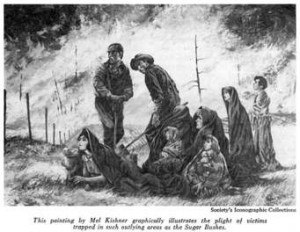 prolonged and widespread drought and high temperatures, capped off by a cyclonic storm in early October. The blaze began at an unknown spot in the dense Wisconsin forest. It first spread to the small village of Sugar Bush, where every resident was killed. There was simply no way of escape for them. High winds then sent the 200 foot flames racing northeast toward the neighboring community of Peshtigo. Temperatures reached 2,000 degrees Fahrenheit, causing trees to explode in the flames. The setting of small fires was a common way to clear forest land for farming and railroad construction. On the day of the Peshtigo Fire, a cold front moved in from the west, bringing strong winds that fanned the fires out of control and escalated them to massive proportions. A firestorm ensued. In the words of Novelist Denise Gess and historian William Lutz, “A firestorm is called nature’s nuclear explosion. Here’s a wall of flame, a mile high, five miles (8 km) wide, traveling 90 to 100 miles per hour (160 km/h), hotter than a crematorium, turning sand into glass.”
prolonged and widespread drought and high temperatures, capped off by a cyclonic storm in early October. The blaze began at an unknown spot in the dense Wisconsin forest. It first spread to the small village of Sugar Bush, where every resident was killed. There was simply no way of escape for them. High winds then sent the 200 foot flames racing northeast toward the neighboring community of Peshtigo. Temperatures reached 2,000 degrees Fahrenheit, causing trees to explode in the flames. The setting of small fires was a common way to clear forest land for farming and railroad construction. On the day of the Peshtigo Fire, a cold front moved in from the west, bringing strong winds that fanned the fires out of control and escalated them to massive proportions. A firestorm ensued. In the words of Novelist Denise Gess and historian William Lutz, “A firestorm is called nature’s nuclear explosion. Here’s a wall of flame, a mile high, five miles (8 km) wide, traveling 90 to 100 miles per hour (160 km/h), hotter than a crematorium, turning sand into glass.”
It would be impossible for most of us to imagine the way the people in that area felt that night. For so many of them, the way of escape, and with it, the hope of life disappeared in a matter of minutes. They didn’t know that the fire was coming until it had cut off their way of escape. Whole families were wiped out, and for the parents…well, I can’t imagine the sick feeling they had, knowing that they could not save their children. The fear the children must have felt, and the fear their parents shared with them…but, nothing could be done. They could only sit and wait for the end, trying not to speak the thoughts they were thinking…trying to give the children comfort and peace, even though their short lives were all they were going to get. So much has been learned over the years about drought and red flag (severe fire danger) days, but back then, they did not have the tools we have now, that can warn us of red flag situations, and even now, there are wildfires that destroy 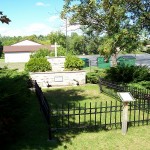 miles and miles of land, and with it towns and homes. If that can happen these days, I can only imagine how easily it could have happened then. Many people have called the Great Peshtigo Fire, the forgotten fire, but in recent years America’s “forgotten fire” has proven to be anything but. The tragedy is a subject of inquiry and debate among meteorologists, astronomers and conservationists. It has been dramatized by novelists and playwrights. It continues to fascinate history buffs and frustrate genealogists, which is where I come in. While the list of the dead from the Great Peshtigo Fire, does not include names I know to belong to my family, the idea of a thousand people unaccounted for in any way, makes me wonder if some of the Wisconsin connections I have been unable to make could be among the lost ones of the Great Peshtigo Fire.
miles and miles of land, and with it towns and homes. If that can happen these days, I can only imagine how easily it could have happened then. Many people have called the Great Peshtigo Fire, the forgotten fire, but in recent years America’s “forgotten fire” has proven to be anything but. The tragedy is a subject of inquiry and debate among meteorologists, astronomers and conservationists. It has been dramatized by novelists and playwrights. It continues to fascinate history buffs and frustrate genealogists, which is where I come in. While the list of the dead from the Great Peshtigo Fire, does not include names I know to belong to my family, the idea of a thousand people unaccounted for in any way, makes me wonder if some of the Wisconsin connections I have been unable to make could be among the lost ones of the Great Peshtigo Fire.
 In days gone by, there just weren’t a lot of construction companies out west. People built their own houses. Of course, if a man has to build his own house, you can bet it took him a while to complete it. I don’t really think a lot of people built their house all by themselves however, because if they lived anywhere near the neighbors, people just seemed to show up to help. I’m not sure just how they knew that you were in the process of building a house or barn back in the old west, but somehow they did, and so they came to help. There was a camaraderie back then that doesn’t always exist today. Too many people don’t want to get involved, or they just decide that they are too busy with their own lives to go and spend time helping others.
In days gone by, there just weren’t a lot of construction companies out west. People built their own houses. Of course, if a man has to build his own house, you can bet it took him a while to complete it. I don’t really think a lot of people built their house all by themselves however, because if they lived anywhere near the neighbors, people just seemed to show up to help. I’m not sure just how they knew that you were in the process of building a house or barn back in the old west, but somehow they did, and so they came to help. There was a camaraderie back then that doesn’t always exist today. Too many people don’t want to get involved, or they just decide that they are too busy with their own lives to go and spend time helping others.
With droughts and thunderstorms causing buildings to burn, and no fire trucks or fire stations available, your neighbors always seemed to be the first responders to fire emergencies, or any other emergency, for that matter. Unfortunately with the neighbors living so far away from each other, the house or barn was usually gone before anyone could get there to help you put out the fire, and when all you are using is a bucket and a wet towel, it’s pretty much a lost cause before you even start. Nevertheless, they were right there to help you rebuild, so that you weren’t left without shelter for your family or your animals. That was just how neighbors were in the old west.
When you think about it, it was how they had to be in order to survive. With the Indian uprisings, and the old west outlaws, the pioneers had to stick together. There wasn’t a lot of lumber companies, and if they homesteaded a piece of land with an abundance of trees on it, they could cut down the trees to clear the field, and use the logs to build the cabin too. That was doing it the hard way, of course, so having friendly neighbors to help you get the job done before winter set in was essential. And of course, meeting the neighbors and offering to help them with their house or barn always meant a big potluck dinner and barn dance when the work was done. They didn’t have to get all dressed up and go somewhere fancy to have a great evening, they just got together with the neighbors and had a hoe down.
With time and modern equipment, came more construction companies, big cities, and less neighborly camaraderie. In fact, people these days are as likely not to know their neighbors as they are to know them. Sad when you think about it. We don’t live in such a big 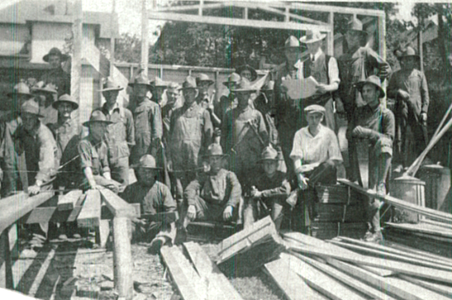 city, that all of that has gone away. Our neighbor, Bill has a snow blower, and if it snows while we are at work, he is out there with that snow blower doing the sidewalks and driveways for about half the block. It’s very nice for Bob to be able to come home and not have to get out the and shovel every thing off. Of course, Bill knows that anytime he needs help, all he has to do is ask, because we will be there with bells on, and likely as not, Bob is out there doing something for Bill before he has a chance to ask. I love our neighbors, and after all, that is what being neighborly is all about.
city, that all of that has gone away. Our neighbor, Bill has a snow blower, and if it snows while we are at work, he is out there with that snow blower doing the sidewalks and driveways for about half the block. It’s very nice for Bob to be able to come home and not have to get out the and shovel every thing off. Of course, Bill knows that anytime he needs help, all he has to do is ask, because we will be there with bells on, and likely as not, Bob is out there doing something for Bill before he has a chance to ask. I love our neighbors, and after all, that is what being neighborly is all about.
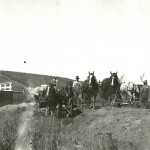 For any one whose ancestors came out to the West, homesteading probably is a word we know, and something we know a little about. Even if it is back in the history of our family, we knew that yes, the land was given to the homesteader, but in reality, they earned every blade of grass that was on their homestead. Homesteading was no easy way to live. Homesteading began when the United States government decided to give 65 acres to anyone who wanted to move out west and settle. They had to work the land for 5 years and then it became theirs. This all sounded like an amazing opportunity to many people, but there were many who came out west to get a homestead and then went back home before the 5 year timeframe was passed. They just couldn’t make it. The didn’t have what it takes. Homesteading was not a lazy man’s way to get land. This land was hard and full of rocks and trees. It had not been plowed and planted before. They would be the first to do that, and they didn’t have all the equipment we have these days to plow up the hard soil so it was suitable for growing crops on.
For any one whose ancestors came out to the West, homesteading probably is a word we know, and something we know a little about. Even if it is back in the history of our family, we knew that yes, the land was given to the homesteader, but in reality, they earned every blade of grass that was on their homestead. Homesteading was no easy way to live. Homesteading began when the United States government decided to give 65 acres to anyone who wanted to move out west and settle. They had to work the land for 5 years and then it became theirs. This all sounded like an amazing opportunity to many people, but there were many who came out west to get a homestead and then went back home before the 5 year timeframe was passed. They just couldn’t make it. The didn’t have what it takes. Homesteading was not a lazy man’s way to get land. This land was hard and full of rocks and trees. It had not been plowed and planted before. They would be the first to do that, and they didn’t have all the equipment we have these days to plow up the hard soil so it was suitable for growing crops on.
My grandparent were among those who came out and earned that homestead, by working that land and making it grow the crops they wanted it to grow. I doubt that they got by without ever losing a crop, because hail, drought, flood, fire, and tornados were bound to have happened at least once during that 5 year timeframe, but they stuck it out and made it work. They proved that they were tough enough to earn that homestead…to the government and to themselves.
Now, don’t get me wrong, I don’t think that the ones that went home were no good, they just didn’t have what it took to make it in the old west. This was rough country, and you  had to be tough to stick it out here. They had to learn to get along with the Indians too, because the Indians weren’t real happy with the White Man being here at all. Treaties had been broken to allow the west to be settled, and they didn’t like it one bit. I think we can all agree that this country was going to expand one way or the other, because as people have children and those children have children, and those children have children, and so on…well, more space was bound to be needed. Still, I suppose we should have handled it in a different way. Nevertheless, many White Men made peace with the Indians, and learned to live together. The White Man had come to the West. He was here to stay, because he had earned that homestead.
had to be tough to stick it out here. They had to learn to get along with the Indians too, because the Indians weren’t real happy with the White Man being here at all. Treaties had been broken to allow the west to be settled, and they didn’t like it one bit. I think we can all agree that this country was going to expand one way or the other, because as people have children and those children have children, and those children have children, and so on…well, more space was bound to be needed. Still, I suppose we should have handled it in a different way. Nevertheless, many White Men made peace with the Indians, and learned to live together. The White Man had come to the West. He was here to stay, because he had earned that homestead.
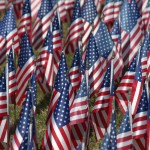 For years now, Bob and I have been coming to Custer, South Dakota in the Black Hills, for our Independence Day celebration. This year is no different…or is it? The heatwave that is hitting our nation right now, the droughts, and the wildfires that are the result of the droughts, are changing the face of Independence Day as we know it. For the first time in all the years we have been coming here, the 4th of July fireworks displays have been cancelled. Of course, we are disappointed, but we fully understand the reasoning behind it, and absolutely support the City of Custer, South Dakota, and their fire department in the decision they have made. The Black Hills have taken such a beating in recent years with wildfires and Pine Beetles, and we don’t want to see any more trees destroyed.
For years now, Bob and I have been coming to Custer, South Dakota in the Black Hills, for our Independence Day celebration. This year is no different…or is it? The heatwave that is hitting our nation right now, the droughts, and the wildfires that are the result of the droughts, are changing the face of Independence Day as we know it. For the first time in all the years we have been coming here, the 4th of July fireworks displays have been cancelled. Of course, we are disappointed, but we fully understand the reasoning behind it, and absolutely support the City of Custer, South Dakota, and their fire department in the decision they have made. The Black Hills have taken such a beating in recent years with wildfires and Pine Beetles, and we don’t want to see any more trees destroyed.
So, what will we do to celebrate our nations independence? We will go out to dinner, and 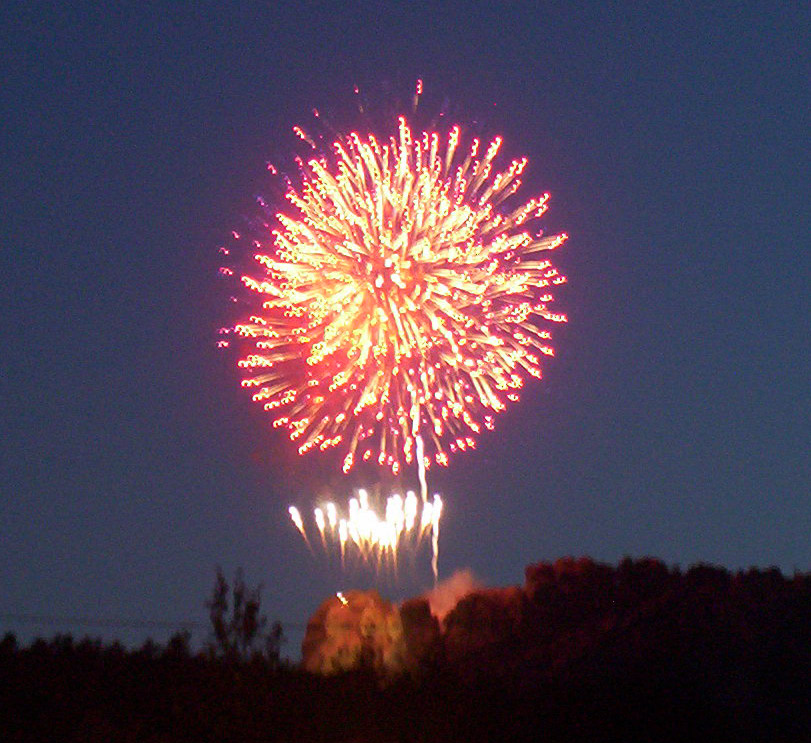 then probably watch some of the fireworks displays in areas of our country who can safely have the shows. Yes, we enjoy the displays, and it doesn’t seem like it can be the 4th of July without them, but as with other things in my life lately, I am finding that sometimes you have to set aside things that you thought were the most important, for things that simply are more important.
then probably watch some of the fireworks displays in areas of our country who can safely have the shows. Yes, we enjoy the displays, and it doesn’t seem like it can be the 4th of July without them, but as with other things in my life lately, I am finding that sometimes you have to set aside things that you thought were the most important, for things that simply are more important.
As with my mom and my in-laws, whose health is not the best right now, the health of these areas of our nation is far more important than the fireworks celebrations that we all love. I seriously doubt if the people of Colorado Springs are thinking much about fireworks, as they worry about whether or not they will have a home to come home to. So, I will continue in prayer for my fellow Americans whose homes are in the path of the multiple fires in our nation.

Today is Independence Day, whether we have fireworks or not. It is our nation’s birthday, and as a proud American, I will celebrate our nation’s birthday with a heart that is filled with gladness…gladness that I am a citizen of this great nation. I will honor those great men and women who have fought and died to give me the freedoms that I am so grateful for and that we Americans sometimes take for granted. I am forever grateful to each and every one of them. Yes, I will celebrate Independence Day…our nation’s birthday…even if it is without the rocket’s red glare.

